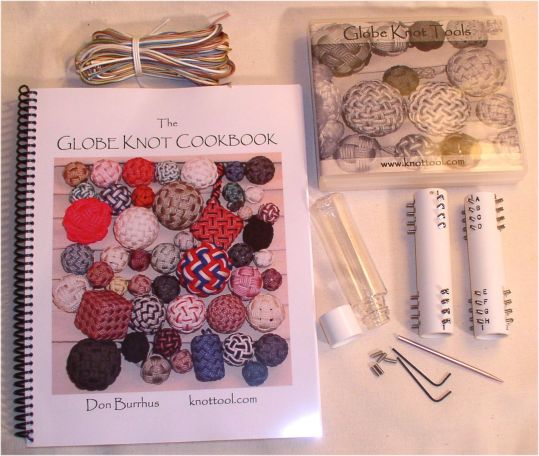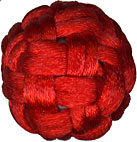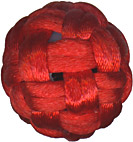Tool and Book Review: Globe Knot Tool and Cookbook
 Don Burrhus has written (at this point) 3 books and sells kits to go with them. Two are about Turks Head Knots and the most recent is about globe knots. I have all of them, but I’ll tackle the Turks Head kit and books more thoroughly at a later date.
Don Burrhus has written (at this point) 3 books and sells kits to go with them. Two are about Turks Head Knots and the most recent is about globe knots. I have all of them, but I’ll tackle the Turks Head kit and books more thoroughly at a later date.
The globe knot kit consists of 2 labeled PVC tubes with 3 and 4 columns of pins. Four at the top and four at the bottom. The pins are these clever little screw type thingies (yes, I’m sure there’s a technical term somewhere that precisely describes the item in question, I just don’t know what that is) that retract into the tube when you don’t need them. A wee little Allen key (included) is used to extract or hide the pins. Extra pins (and an extra Allen key) are included in case you lose one. Blind cord (yes, the kind of cord used to pull up and down window blinds, firmly braided round nylon/polyester 1.5mm??) in an assortment of colours is included. A self-threading needle completes the kit and the whole is packed into what looks like a repurposed multiple CD case.
My biggest complaint about the kit itself is that the little bottle that holds the Allen keys and extra pins is too big (diameter) for the case. A smaller bottle or a little resealable bag would allow your case to close entirely (yes, I am aware that’s a pretty nit-picky complaint, but you have to start somewhere 8), so I moved my little bits into a snack size zip bag and now I’m a happier person. 8)
The book is a standard 8.5” x 11” spiral-bound for easy reference while tying with a plastic front and back to give it some structure. The book has 202 pages with instructions for 137 knots, most of which are unique to this book. It’s the kind of thing to make a knot fanatic (the kind always looking for new knots) jump up and down in glee, if they were prone to that sort of behavior. 8)
The front matter of the book includes a number of colour plates with crowds of tied knots and accompanying maps that indicate which knot is which. There is also a step-by-step illustrated section that shows how to use the tools. The appendix includes a bibliography, some cord usage and core sizing formulas, material sources, and a discussion of Ashley’s globe knots.
The instructions for each knot is contained on one page. There is a pin diagram (which pins are used for this knot), a knot schematic, a facet count, a shape diagram, and a tying formula based on pin numbers with interim overs and unders. The crowd of knots on the cover is nice and makes for a great cover, but I would have much preferred more orderly knot arrangements (with their descriptions). This is a minor point. What I would have vastly preferred is a picture of the knot in question on it’s instruction page. I have not gone through the book to the extent that I would be able to say whether or not each set of instructions has a photo of the completed knot in the book. Something the Japanese books I buy like to do (so that they can have colour plates at the front of the book and cheaper paper with monochrome text and diagrams in the rest of the book) is to label an object in the colour plate section with the page number/range of their instructions and in the instruction section. Conversely, they note on the instruction pages where to find the appropriate colour plate page to supplement the grey-scale illustrations).
Clearly, this is not a deal-breaker. For anyone the least bit interested in globe knots, I highly recommend both book and kit. Perhaps Don will tweak the format for his future books. 8)
Speaking of tweaks I’d like to see, I’d love for a recommended length of cord and core size (the length of cord and core size for the examples he made would do nicely) just as a reference point for the impatient who don’t want to work through the formulas while fooling around.
Beads

 Now, you take any object and put a hole in it somewhere and you have a bead, especially if it’s round. So, I looked at these round knots and thought, put a bead in as core, and the whole thing is a bead! My first globe knot from the book was one of the step by step walk through knots from the front (so it’s either the 28 or the 40 facet knot). I honestly can’t tell from looking at it and at the moment have no patience for counting.
Now, you take any object and put a hole in it somewhere and you have a bead, especially if it’s round. So, I looked at these round knots and thought, put a bead in as core, and the whole thing is a bead! My first globe knot from the book was one of the step by step walk through knots from the front (so it’s either the 28 or the 40 facet knot). I honestly can’t tell from looking at it and at the moment have no patience for counting.
As with all things beady, I showed my new bead to my bead group and a number of them were interested in learning, so I’ll be teaching a bead knot to the group this weekend (Jan 18, 2009). I just need to pick one. I’m working my way through the book and trying to pick the one with minimal facets that looks nice. I’ve come up with a low cost alternative to the snazzy tool so that all in the group can have one. More on that later.
Administrivia: I was noticing that the anonymous user sees an entirely different date stamp on the posts than the registered users do. Of course, this is only relevant to me because the anonymous user might think that wasn’t hitting the one a day mark due to the funky time stamps. 8P 8( Something to fix another day… 8)
Comments
Globe Knot Cookbook
Globe Knots...